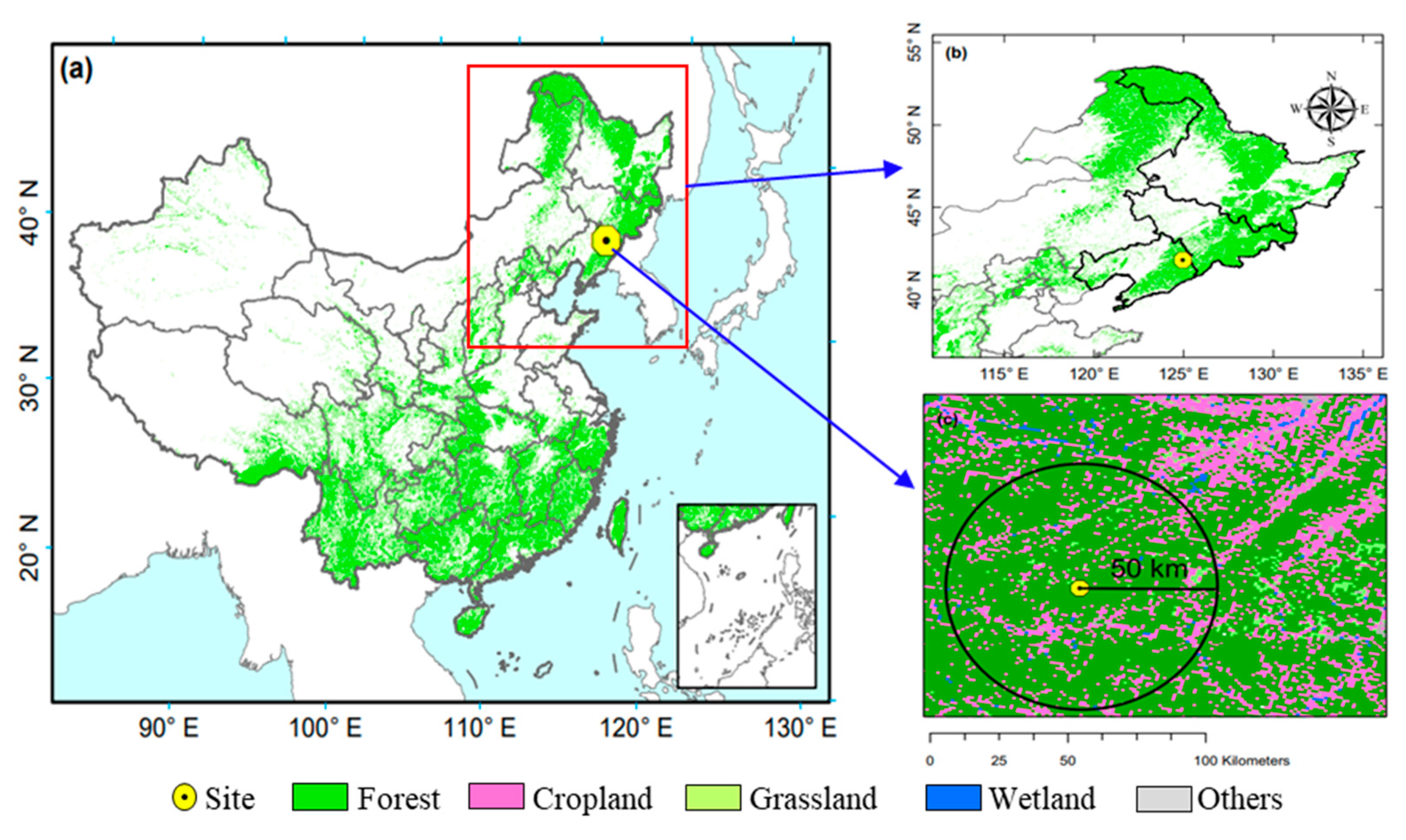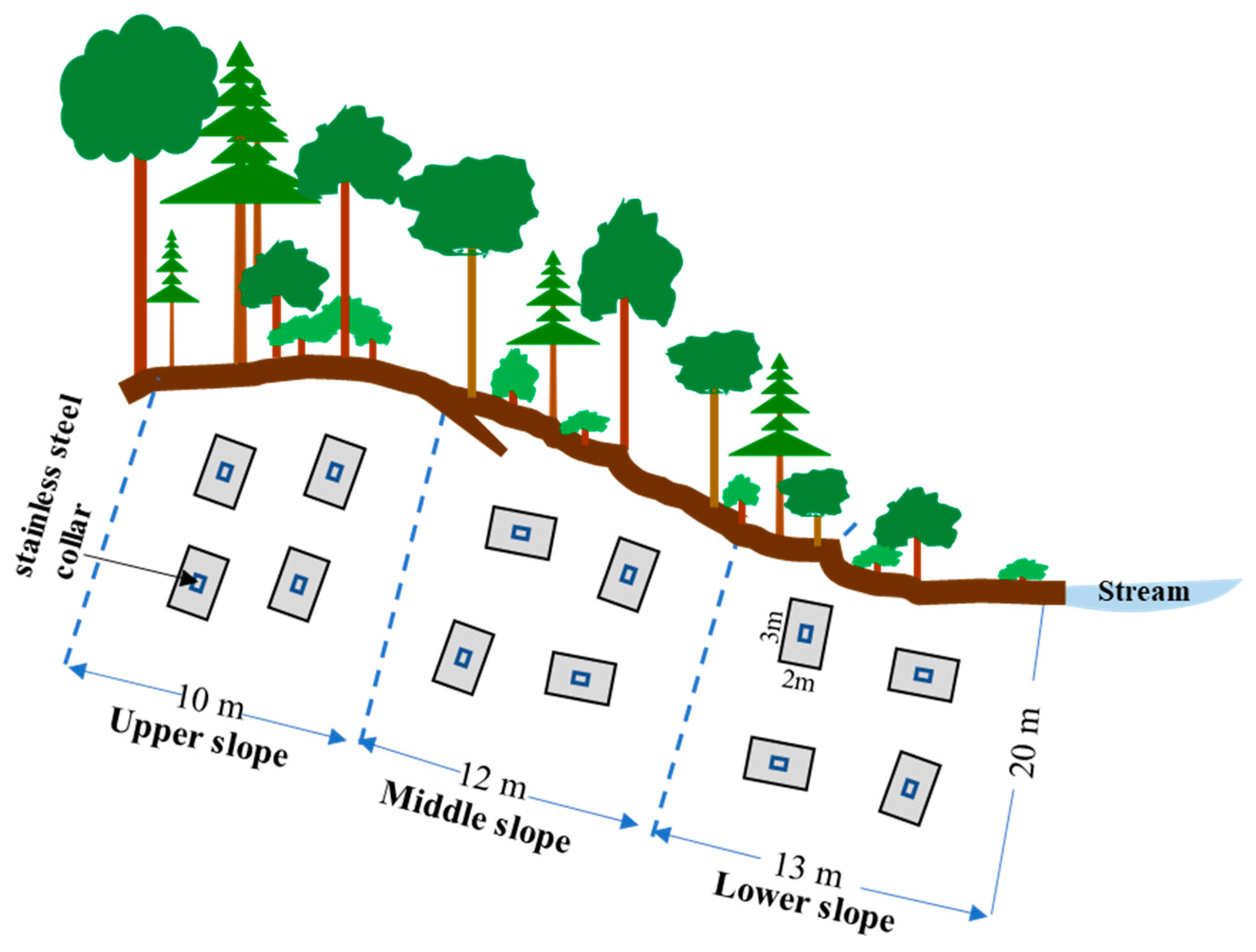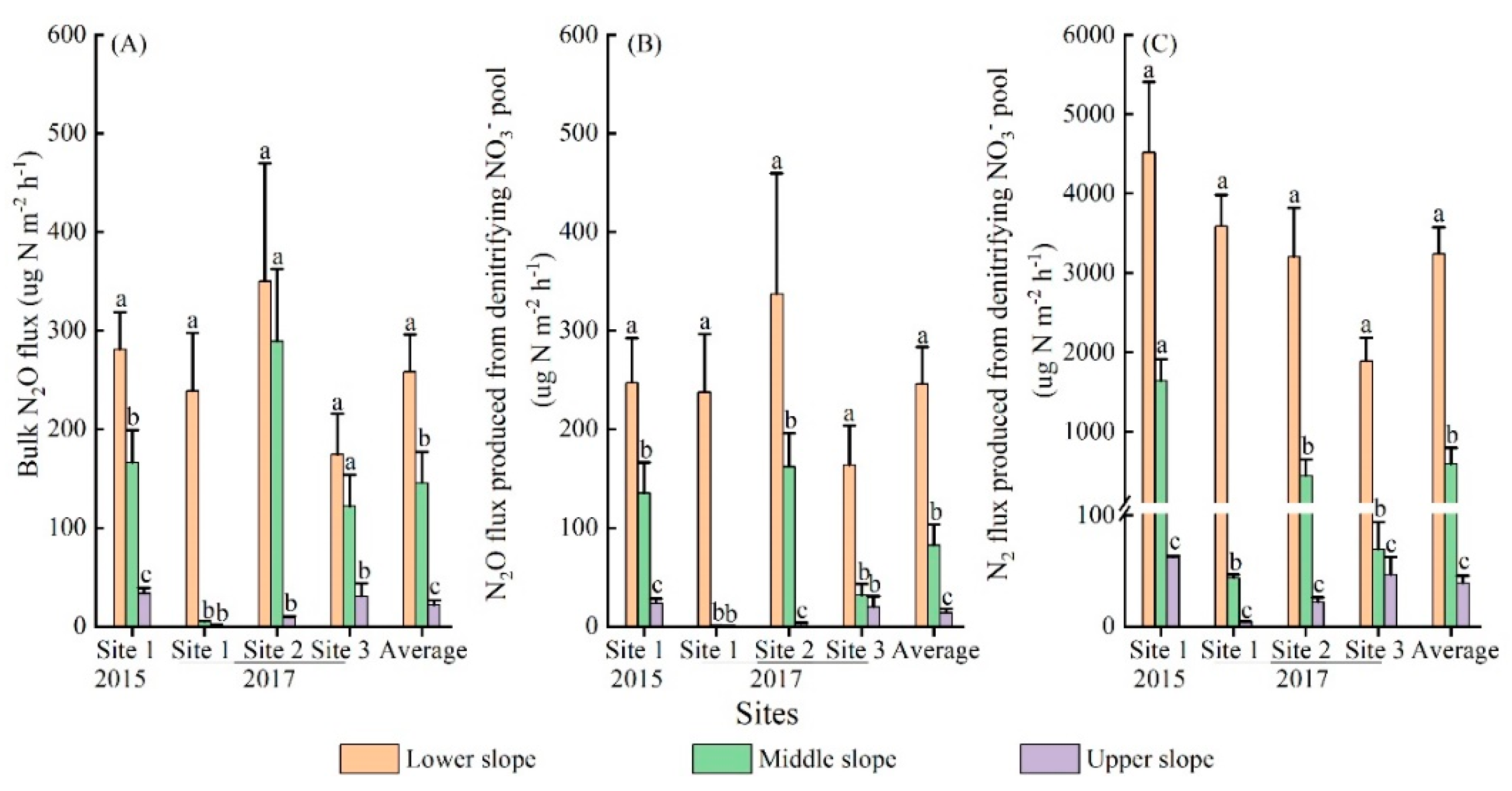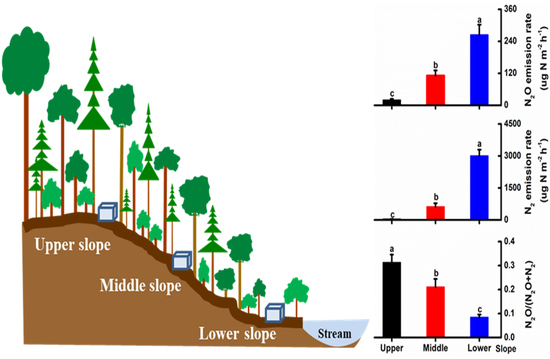Spatial Variations of Soil N2 and N2O Emissions from a Temperate Forest: Quantified by the In Situ 15N Labeling Method
Abstract
:1. Introduction
2. Materials and Methods
2.1. Site Description
2.2. Field 15N Labeling Experiment
2.3. Soil N2O, N2 Analysis and Flux Calculation
2.4. Soil Parameter Analysis
2.5. Statistical Analyses
3. Results
3.1. Soil Physical-Chemical Parameters
3.2. Soil N2O and N2 Emissions
3.3. Soil N2O/(N2O + N2) Ratio
3.4. Relationships between Gaseous N Rates, Ratios, and Soil Properties
4. Discussion
4.1. Variations of Soil N2 and N2O Emissions
4.2. Comparison of Soil N2O/(N2O + N2) Ratios from Denitrification
4.3. Implications for Ecosystem N Loss
5. Conclusions
Supplementary Materials
Author Contributions
Funding
Data Availability Statement
Acknowledgments
Conflicts of Interest
References
- Butterbach-Bahl, K.; Baggs, E.M.; Dannenmann, M.; Kiese, R.; Zechmeister-Boltenstern, S. Nitrous oxide emissions from soils: How well do we understand the processes and their controls? Philos. Trans. R. Soc. B 2013, 368, 20130122. [Google Scholar] [CrossRef] [PubMed]
- Galloway, J.N.; Dentener, F.J.; Capone, D.G.; Boyer, E.W.; Howarth, R.W.; Seitzinger, S.P.; Asner, G.P.; Green, P.A.; Holland, E.A. Nitrogen cycles: Past, present, and future. Biogeochemistry 2004, 70, 153–226. [Google Scholar] [CrossRef]
- Stange, C.F.; Spott, O.; Arriaga, H.; Menendez, S.; Estavillo, J.M.; Merino, P. Use of the inverse abundance approach to identify the sources of NO and N2O release from Spanish forest soils under oxic and hypoxic conditions. Soil Biol. Biochem. 2013, 57, 451–458. [Google Scholar] [CrossRef]
- Wallenstein, M.D.; Myrold, D.D.; Firestone, M.; Voytek, M. Environmental controls on denitrifying communities and denitrification rates: Insights from molecular methods. Ecol. Appl. 2006, 16, 2143–2152. [Google Scholar] [CrossRef]
- Groffman, P.M.; Altabet, M.A.; Böhlke, J.K.; Butterbach-Bahl, K.; David, M.B.; Firestone, M.K.; Giblin, A.E.; Kana, T.M.; Nielsen, L.P.; Voytek, M.A. Methods for measuring denitrification: Diverse approaches to a difficult problem. Ecol. Appl. 2006, 16, 2091–2122. [Google Scholar] [CrossRef]
- Yoshinari, T.; Hynes, R.; Knowles, R. Acetylene inhibition of nitrous oxide reduction and measurement of denitrification and nitrogen fixation in soil. Soil Biol. Biochem. 1977, 9, 177–183. [Google Scholar] [CrossRef]
- Morse, J.L.; Bernhardt, E.S. Using 15N tracers to estimate N2O and N2 emissions from nitrification and denitrification in coastal plain wetlands under contrasting land-uses. Soil Biol. Biochem. 2013, 57, 635–643. [Google Scholar] [CrossRef]
- Yang, W.H.; McDowell, A.C.; Brooks, P.D.; Silver, W.L. New high precision approach for measuring 15N-N2 gas fluxes from terrestrial ecosystems. Soil Biol. Biochem. 2014, 69, 234–241. [Google Scholar] [CrossRef]
- Morse, J.L.; Durán, J.; Groffman, P.M. Soil denitrification fluxes in a northern Hardwood forest: The importance of snowmelt and implications for ecosystem N budgets. Ecosystems 2015, 18, 520–532. [Google Scholar] [CrossRef]
- Morse, J.L.; Durán, J.; Beall, F.; Enanga, E.M.; Creed, I.F.; Fernandez, I.; Groffman, P.M. Soil denitrification fluxes from three northeastern North American forests across a range of nitrogen deposition. Oecologia 2015, 177, 17–27. [Google Scholar] [CrossRef]
- Butterbach-Bahl, K.; Willibald, G.; Papen, H. Soil core method for direct simultaneous determination of N2 and N2O emissions from forest soils. Plant Soil 2002, 240, 105–116. [Google Scholar] [CrossRef]
- Wang, R.; Feng, Q.; Liao, T.T.; Zheng, X.H.; Butterbach-Bahl, K.; Zhang, W.; Jin, C.Y. Effects of nitrate concentration on the denitrification potential of a calcic cambisol and its fractions of N2, N2O and NO. Plant Soil 2013, 363, 175–189. [Google Scholar] [CrossRef]
- Wang, R.; Pan, Z.L.; Zheng, X.H.; Ju, X.T.; Yao, Z.S.; Butterbach-Bahl, K.; Zhang, C.; Wei, H.H.; Huang, B.X. Using field-measured soil N2O fluxes and laboratory scale parameterization of N2O/(N2O + N2) ratios to quantify field-scale soil N2 emissions. Soil Biol. Biochem. 2020, 148, 107904. [Google Scholar] [CrossRef]
- Boyer, E.W.; Alexander, R.B.; Parton, W.J.; Li, C.S.; Butterbach-Bahl, K.; Donner, S.D.; Skaggs, R.W.; Del Gross, S.J. Modeling denitrification in terrestrial and aquatic ecosystems at regional scales. Ecol. Appl. 2006, 16, 2123–2142. [Google Scholar] [CrossRef]
- Weier, K.L.; Doran, J.W.; Power, J.F.; Walters, D.T. Denitrification and the dinitrogen/nitrous oxide ratio as affected by soil water; available carbon; and nitrate. Soil Sci. Soc. Am. J. 1993, 57, 66–72. [Google Scholar] [CrossRef]
- Schlesinger, W.H. On the fate of anthropogenic nitrogen. Proc. Natl. Acad. Sci. USA 2009, 106, 203–208. [Google Scholar] [CrossRef]
- Saggar, S.; Jha, N.; Deslippe, J.; Bolan, N.S.; Luo, J.; Giltrap, D.L.; Kim, D.G.; Zaman, M.; Tillman, R.W. Denitrification and N2O:N2 production in temperate grasslands: Processes; measurements; modelling and mitigating negative impacts. Sci. Total Environ. 2013, 465, 173–195. [Google Scholar] [CrossRef]
- Kulkarni, M.V.; Groffman, P.M.; Yavitt, J.B.; Goodale, C.L. Complex controls of denitrification at ecosystem; landscape and regional scales in northern hardwood forests. Ecol. Model. 2015, 298, 39–52. [Google Scholar] [CrossRef]
- Liptzin, D.; Silver, W.L. Spatial patterns in oxygen and redox sensitive biogeochemistry in tropical forest soils. Ecosphere 2015, 6, 211. [Google Scholar] [CrossRef]
- Well, R.; Burkart, S.; Giesemann, A.; Grosz, B.; Koester, J.R.; Lewicka-Szczebak, D. Improvement of the 15N gas flux method for in situ measurement of soil denitrification and its product stoichiometry. Rapid Commun. Mass Spectrom. 2019, 33, 437–448. [Google Scholar] [CrossRef]
- Burgin, A.J.; Groffman, P.M. Soil O2 controls denitrification rates and N2O yield in a riparian wetland. J. Geophys. Res. 2012, 117, 1010. [Google Scholar] [CrossRef]
- Lai, T.V.; Denton, M.D. N2O and N2 emissions from denitrification respond differently to temperature and nitrogen supply. J. Soils Sediment 2018, 18, 1548–1557. [Google Scholar] [CrossRef]
- Senbayram, M.; Well, R.; Bol, R.; Chadwick, D.R.; Jones, D.L.; Wu, D. Interaction of straw amendment and soil NO3− content controls fungal denitrification and denitrification product stoichiometry in a sandy soil. Soil Biol. Biochem. 2018, 126, 204–212. [Google Scholar] [CrossRef]
- Scheer, C.; Fuchs, K.; Pelster, D.E.; Butterbach-Bahl, K. Estimating global terrestrial denitrification from measured N2O:(N2O + N2) product ratios. Curr. Opin. Env. Sust. 2020, 47, 72–80. [Google Scholar] [CrossRef]
- Mogge, B.; Kaiser, E.A.; Munch, J.C. Nitrous oxide emissions and denitrification N-losses from forest soils in the Bornhöved Lake region (Northern Germany). Soil Biol. Biochem. 1998, 30, 703–710. [Google Scholar] [CrossRef]
- Bai, E.; Li, W.; Li, S.L.; Sun, J.F.; Peng, B.; Dai, W.W.; Jiang, P.; Han, S.J. Pulse increase of soil N2O emission in response to N addition in a temperate forest on Mt Changbai; Northeast China. PLoS ONE 2014, 9, e102765. [Google Scholar]
- Kulkarni, M.V.; Burgin, A.J.; Groffman, P.M.; Yavitt, J.B. Direct flux and 15N tracer methods for measuring denitrification in forest soils. Biogeochemistry 2014, 117, 359–373. [Google Scholar] [CrossRef]
- Sgouridis, F.; Ullah, S. Relative magnitude and controls of in situ N2 and N2O fluxes due to denitrification in natural and seminatural terrestrial ecosystems using 15N tracers. Environ. Sci. Technol. 2015, 49, 14110–14119. [Google Scholar] [CrossRef]
- Pan, Y.; Birdsey, R.A.; Fang, J.; Houghton, R.; Kauppi, P.E.; Kurz, W.A.; Phillips, O.L.; Shvidenko, A.; Lewis, S.L.; Canadell, J.G.A. A large and persistent carbon sink in the world’s forests. Science 2011, 333, 988–993. [Google Scholar] [CrossRef]
- Tang, W.G.; Chen, D.X.; Phillips, O.L.; Liu, X.; Zhou, Z.; Li, Y.D.; Xi, D.; Zhu, F.F.; Fang, J.Y.; Zhang, L.M.; et al. Effects of long-term increased N deposition on tropical montane forest soil N2 and N2O emissions. Soil Biol. Biochem. 2018, 126, 194–203. [Google Scholar] [CrossRef]
- Friedl, J.; Scheer, C.; Rowlings, D.W.; McIntosh, H.V.; Strazzabosco, A.; Warner, D.I.; Grace, P.R. Denitrification losses from an intensively managed sub-tropical pasture–Impact of soil moisture on the partitioning of N2 and N2O emissions. Soil Biol. Biochem. 2016, 92, 58–66. [Google Scholar] [CrossRef]
- Luo, J.; Tillman, R.W.; Ball, P.R. Nitrogen loss through denitrification in a soil under pasture in New Zealand. Soil Biol. Biochem. 2000, 32, 497–509. [Google Scholar] [CrossRef]
- Zhu, J.J.; Mao, Z.H.; Hu, L.L.; Zhang, J.X. Plant diversity of secondary forests in response to anthropogenic disturbance levels in montane regions of northeastern China. J. Forest Res. 2007, 12, 403–416. [Google Scholar] [CrossRef]
- Huang, K.; Su, C.X.; Liu, D.W.; Duan, Y.H.; Kang, R.H.; Yu, H.M.; Liu, Y.Q.; Li, X.; Gurmesa, G.A.; Quan, Z.; et al. A strong temperature dependence of soil nitric oxide emission from a temperate forest in Northeast China. Agric. For. Meteorol. 2022, 323, 109035. [Google Scholar] [CrossRef]
- Huang, S.N.; Elliott, M.M.; Felix, J.D.; Pan, Y.P.; Liu, D.W.; Li, S.L.; Li, Z.J.; Zhu, F.F.; Zhang, N.; Fu, P.P.; et al. Seasonal pattern of ammonium 15N natural abundance in precipitation at a rural forested site and implications for NH3 source partitioning. Environ. Pollut. 2019, 247, 541–549. [Google Scholar] [CrossRef] [PubMed]
- Yang, K.; Zhu, J.J.; Yan, Q.L.; Sun, O.J. Changes in soil P chemistry as affected by conversion of natural secondary forests to larch plantations. Forest Ecol. Manag. 2010, 260, 422–428. [Google Scholar] [CrossRef]
- Xi, D.; Bai, R.; Zhang, L.M.; Fang, Y.T. Contribution of anammox to nitrogen removal in two temperate forest soils. Appl. Environ. Microbiol. 2016, 82, 4602–4612. [Google Scholar] [CrossRef]
- Li, S.L.; Gurmesa, G.A.; Zhu, W.X.; Gundersen, R.P.; Zhang, S.S.; Xi, D.; Huang, S.N.; Wang, A.; Zhu, F.F.; Jiang, Y.; et al. Fate of atmospherically deposited NH4+ and NO3− in two temperate forests in China: Temporal pattern and redistribution. Ecol. Appl. 2019, 29, e01920. [Google Scholar] [CrossRef]
- Kaiser, J.; Röckmann, T.; Brenninkmeijer, C.A.M. Complete and accurate mass spectrometric isotope analysis of tropospheric nitrous oxide. J. Geophys. Res. 2003, 108, 4476. [Google Scholar] [CrossRef]
- Buchen, C.; Lewicka-Szczebak, D.; Fuss, R.; Helfrich, M.; Flessa, H.; Well, R. Fluxes of N2 and N2O and contributing processes in summer after grassland renewal and grassland conversion to maize cropping on a Plaggic Anthrosol and a Histic Gleysol. Soil Biol. Biochem. 2016, 101, 6–19. [Google Scholar] [CrossRef]
- Sgouridis, F.; Stott, A.; Ullah, S. Application of the 15N gas-flux method for measuring in situ N2 and N2O fluxes due to denitrification in natural and semi-natural terrestrial ecosystems and comparison with the acetylene inhibition technique. Biogeosciences 2016, 13, 1821–1835. [Google Scholar] [CrossRef] [Green Version]
- Spott, O.; Russow, R.; Apelt, B.; Stange, C.F. A 15N-aided artificial atmosphere gas flow technique for online determination of soil N2 release using the zeolite Kostrolith SX6 (R). Rapid Commun. Mass Spectrom. 2006, 20, 3267–3274. [Google Scholar] [CrossRef] [PubMed]
- Baily, A.; Watson, C.J.; Laughlin, R.; Matthews, D.; McGeough, K.; Jordan, P. Use of the 15N gas flux method to measure the source and level of N2O and N2 emissions from grazed grassland. Nutr. Cycl. Agroecosyst. 2012, 94, 287–298. [Google Scholar] [CrossRef]
- Koba, K.; Hirobe, M.; Koyama, L.; Kohzu, A.; Tokuchi, N.; Nadelhoffer, K.J.; Wada, E.; Takeda, H. Natural 15N abundance of plants and soil N in a temperate coniferous forest. Ecosystems 2003, 6, 457–469. [Google Scholar] [CrossRef]
- Ullah, S.; Breitenbeck, G.A.; Faulkner, S.P. Denitrification and N2O emission from forested and cultivated alluvial clay soil. Biogeochemistry 2005, 73, 499–513. [Google Scholar] [CrossRef]
- Well, R.; Maier, M.; Lewicka-Szczebak, D.; Koster, J.R.; Ruoss, N. Underestimation of denitrification rates from field application of the 15N gas flux method and its correction by gas diffusion modelling. Biogeosciences 2019, 16, 2233–2246. [Google Scholar] [CrossRef]
- Scholefield, D.; Hawkins, J.M.B.; Jackson, S.M. Use of a flowing helium atmosphere incubation technique to measure the effects of denitrification controls applied to intact cores of a clay soil. Soil Biol. Biochem. 1997, 29, 1337–1344. [Google Scholar] [CrossRef]
- Zaman, M.; Kleineidam, K.; Bakken, L.; Berendt, J.; Bracken, C.; Butterbach-Bahl, K.; Cai, Z.; Chang, S.X.; Clough, T.; Dawar, K.; et al. Isotopic techniques to measure N2O, N2 and their sources. In Measuring Emission of Agricultural Greenhouse Gases and Developing Mitigation Options Using Nuclear and Related Techniques: Applications of Nuclear Techniques for GHGs; Zaman, M., Heng, L., Müller, C., Eds.; Springer International Publishing: Cham, Switzerland, 2021; pp. 213–301. [Google Scholar]
- Zhang, J.B.; Zhu, T.B.; Cai, Z.C.; Müller, C. Nitrogen cycling in forest soils across climate gradients in Eastern China. Plant Soil 2011, 342, 419–432. [Google Scholar] [CrossRef]
- Houlton, B.Z.; Sigman, D.M.; Hedin, L.O. Isotopic evidence for large gaseous nitrogen losses from tropical rainforests. Proc. Natl. Acad. Sci. USA 2006, 103, 8745–8750. [Google Scholar] [CrossRef]
- Bai, E.; Houlton, B.Z. Coupled isotopic and process-based modeling of gaseous nitrogen losses from tropical rain forests. Global Biogeochem. Cycles 2009, 23, GB2011. [Google Scholar] [CrossRef]
- Fang, Y.T.; Koba, K.; Makabe, A.; Takahashi, C.; Zhu, W.X.; Hayashi, T.; Hokari, A.A.; Urakawa, R.; Bai, E.; Houlton, B.Z.; et al. Microbial denitrification dominates nitrate losses from forest ecosystems. Proc. Natl. Acad. Sci. USA 2015, 115, 1470–1474. [Google Scholar] [CrossRef] [PubMed] [Green Version]
- Zhou, W.J.; Xi, D.; Fang, Y.T.; Wang, A.; Sha, L.Q.; Song, Q.H.; Liu, Y.T.; Zhou, L.G.; Zhou, R.W.; Lin, Y.X.; et al. Microbial processes responsible for soil N2O production in a tropical rainforest, illustrated using an in situ 15N labeling approach. CATENA 2021, 202, 105214. [Google Scholar] [CrossRef]




| Slope Position | Site | Year | BD (g cm−3) | pH | WFPS (%) | TOC (g kg−1) | TN (g kg−1) | C/N Ratio | NH4+ (mg N kg−1) | NO3− (mg N kg−1) | NH4+/NO3− Ratio |
|---|---|---|---|---|---|---|---|---|---|---|---|
| Upper | Site 1 | 2015 | 0.60 ± 0.06 a | 5.4 ± 0.0 b | 36 ± 4 c | 4.7 ± 0.2 b | 0.47 ± 0.02 b | 10.2 ± 0.1 c | 2.1 ± 0.1 b | 2.9 ± 0.1 a | 0.7 ± 0.0 b |
| Site 1 | 2017 | 0.58 ± 0.01 a | 5.6 ± 0.1 a | 40 ± 1 c | 7.7 ± 1.3 a | 0.74 ± 0.09 a | 10.2 ± 0.5 a | 5.9 ± 0.7 a | 1.5 ± 0.2 a | 3.9 ± 0.1 a | |
| Site 2 | 0.56 ± 0.01 a | 5.9 ± 0.1 a | 28 ± 1 c | 5.8 ± 0.2 b | 0.58 ± 0.01 b | 9.9 ± 0.1 b | 8.0 ± 0.3 a | 1.7 ± 0.1 a | 4.7 ± 0.2 a | ||
| Site 3 | 0.60 ± 0.05 a | 5.9 ± 0.1 a | 40 ± 5 c | 6.0 ± 0.4 a | 0.62 ± 0.03 a | 9.4 ± 0.1 c | 6.4 ± 0.3 a | 1.4 ± 0.1 a | 4.7 ± 0.4 a | ||
| Total | 0.59 ± 0.02 a | 5. 7 ± 0.1 a | 35 ± 2 c | 6.0 ± 0.4 b | 0.58 ± 0.03 b | 9.9 ± 0.1 b | 5.3 ± 0.7 b | 2.0 ± 0.2 a | 3.2 ± 0.5 b | ||
| Middle | Site 1 | 2015 | 0.48 ± 0.03 a | 5.6 ± 0.1 a | 67 ± 4 b | 5.1 ± 0.3 b | 0.44 ± 0.04 b | 11.7 ± 0.4 b | 2.6 ± 0.8 b | 2.9 ± 0.3 a | 0.8 ± 0.2 b |
| Site 1 | 2017 | 0.53 ± 0.02 ab | 5.6 ± 0.0 a | 69 ± 2 a | 8.5 ± 0.8 a | 1.01 ± 0.16 a | 10.2 ± 0.5 a | 7.4 ± 0. 9 a | 1.6 ± 0.2 a | 4.8 ± 1.1 a | |
| Site 2 | 0.49 ± 0.06 a | 6.0 ± 0.1 a | 59 ± 6 b | 7.5 ± 0.9 b | 0.69 ± 0.11 ab | 10.8 ± 0.7 ab | 9.2 ± 1.5 a | 2.9 ± 0.7 a | 3.8 ± 0.9 a | ||
| Site 3 | 0.56 ± 0.01 a | 5.8 ± 0.1 a | 65 ± 3 b | 8.6 ± 1.6 a | 0.79 ± 0.11 a | 10.4 ± 0.5 ab | 9.4 ± 1.5 a | 1.1 ± 0.2 a | 9.4 ± 2.5 a | ||
| Total | 0.52 ± 0.02 ab | 5.7 ± 0.1 a | 65 ± 2 b | 7.4 ± 0.6 b | 0.71 ± 0.07 ab | 10.8 ± 0.3 b | 7.1 ± 1.0 ab | 2.2 ± 0.3 a | 4.7 ± 1.1 b | ||
| Lower | Site 1 | 2015 | 0.44 ± 0.07 a | 5.3 ± 0.1 b | 128 ± 35 a | 15.0 ± 3.2 a | 1.07 ± 0.18 a | 13.8 ± 0.6 a | 10.4 ± 1.8 a | 2.0 ± 0.5 a | 5.6 ± 0.9 a |
| Site 1 | 2017 | 0.49 ± 0.02 b | 5.5 ± 0.0 a | 100 ± 5 a | 9.1 ± 1.2 a | 0.80 ± 0.10 a | 11.4 ± 0.5 a | 7.3 ± 0. 8 a | 1.0 ± 0.2 a | 8.1 ± 1.8 a | |
| Site 2 | 0.46 ± 0.06 a | 5.9 ± 0.1 a | 83 ± 8 a | 10.2 ± 0.7 a | 0.89 ± 0.04 a | 11.5 ± 0.3 a | 10.5 ± 1.8 a | 1.0 ± 0.3 a | 11.8 ± 1.5 a | ||
| Site 3 | 0.47 ± 0.10 a | 6.0 ± 0.1 a | 111 ± 24 a | 8.5 ± 3.3 a | 0.72 ± 0.25 a | 11.4 ± 0.6 a | 9.1 ± 3.6 a | 1.7 ± 0.5 a | 6.4 ± 1.9 a | ||
| Total | 0.47 ± 0.03 b | 5.7 ± 0.1 a | 105 ± 9 a | 10.3 ± 1.1 a | 0.85 ± 0.08 a | 11.9 ± 0.3 a | 9.1 ± 1.0 a | 1.4 ± 0.2 b | 8.1 ± 1.0 a |
| Slope Positions | Area (%) | N2Odenitrification (μg N m−2 h−1) | Bulk N2O (μg N m−2 h−1) | N2denitrification (μg N m−2 h−1) | Total N2 (μg N m−2 h−1) | Denitrification (μg N m−2 h−1) | RN2O | RN2O-total |
|---|---|---|---|---|---|---|---|---|
| Upper | 80 | 14 ± 4 c | 22 ± 5 c | 39 ± 7 c | 85 ± 15 c | 54 ± 10 c | 0.22 ± 0.03 a | 0.20 ± 0.02 a |
| Middle | 15 | 82 ± 21 b | 145 ± 32 b | 594 ± 205 b | 896 ± 243 b | 676 ± 220 b | 0.20 ± 0.05 a | 0.18 ± 0.04 a |
| Lower | 5 | 246 ± 38 a | 258 ± 37 a | 3243 ± 330 a | 3442 ± 342 a | 3488 ± 340 a | 0.08 ± 0.01 b | 0.08 ± 0.01 b |
| Total | 100 | 36 ± 8 | 52 ± 11 | 282 ± 53 | 375 ± 66 | 319 ± 58 | 0.16 ± 0.02 | 0.15 ± 0.02 |
| N2denitrifcation | N2Odenitrifcation | Denitrification | RN2O | RN2O-total | Bulk N2O | Total N2 | |
|---|---|---|---|---|---|---|---|
| BD | −0.36 * | −0.34 * | −0.37 * | 0.19 | 0.26 | −0.38 * | −0.37 * |
| pH | −0.24 | 0.05 | −0.22 | 0.20 | 0.27 | 0.10 | −0.23 |
| WFPS | 0.74 ** | 0.51 ** | 0.73 ** | −0.39 ** | −0.41 ** | 0.47 ** | 0.75 ** |
| TOC | 0.45 ** | 0.38 * | 0.46 ** | −0.16 | −0.18 | 0.42 ** | 0.45 ** |
| TN | 0.29 | 0.24 | 0.29 | −0.12 | −0.14 | 0.28 | 0.28 |
| C/N ratio | 0.62 ** | 0.54 ** | 0.63 ** | −0.35 * | −0.39 * | 0.52 ** | 0.63 ** |
| NH4+ | 0.23 | 0.19 | 0.23 | 0.01 | 0.05 | 0.28 | 0.22 |
| NO3− | −0.21 | −0.18 | −0.21 | 0.11 | 0.03 | −0.17 | −0.19 |
| NH4+/NO3− ratio | 0.31 * | 0.43 ** | 0.33 * | −0.06 | 0.01 | 0.46 ** | 0.30 * |
| Species | WFPS | BD | C/N Ratio | NH4+/NO3− Ratio | R2 |
|---|---|---|---|---|---|
| N2denitrification | 0.72 ** | −0.32 ** | 0.63 | ||
| N2Odenitrification | 0.48 ** | 0.35 ** | 0.38 | ||
| Denitrification | 0.71 ** | −0.33 ** | 0.63 | ||
| RN2O | −0.38 * | 0.13 | |||
| Bulk N2O | 0.45 ** | 0.38 ** | 0.38 |
Publisher’s Note: MDPI stays neutral with regard to jurisdictional claims in published maps and institutional affiliations. |
© 2022 by the authors. Licensee MDPI, Basel, Switzerland. This article is an open access article distributed under the terms and conditions of the Creative Commons Attribution (CC BY) license (https://creativecommons.org/licenses/by/4.0/).
Share and Cite
Xi, D.; Fang, Y.; Zhu, W. Spatial Variations of Soil N2 and N2O Emissions from a Temperate Forest: Quantified by the In Situ 15N Labeling Method. Forests 2022, 13, 1347. https://doi.org/10.3390/f13091347
Xi D, Fang Y, Zhu W. Spatial Variations of Soil N2 and N2O Emissions from a Temperate Forest: Quantified by the In Situ 15N Labeling Method. Forests. 2022; 13(9):1347. https://doi.org/10.3390/f13091347
Chicago/Turabian StyleXi, Dan, Yunting Fang, and Weixing Zhu. 2022. "Spatial Variations of Soil N2 and N2O Emissions from a Temperate Forest: Quantified by the In Situ 15N Labeling Method" Forests 13, no. 9: 1347. https://doi.org/10.3390/f13091347
APA StyleXi, D., Fang, Y., & Zhu, W. (2022). Spatial Variations of Soil N2 and N2O Emissions from a Temperate Forest: Quantified by the In Situ 15N Labeling Method. Forests, 13(9), 1347. https://doi.org/10.3390/f13091347







